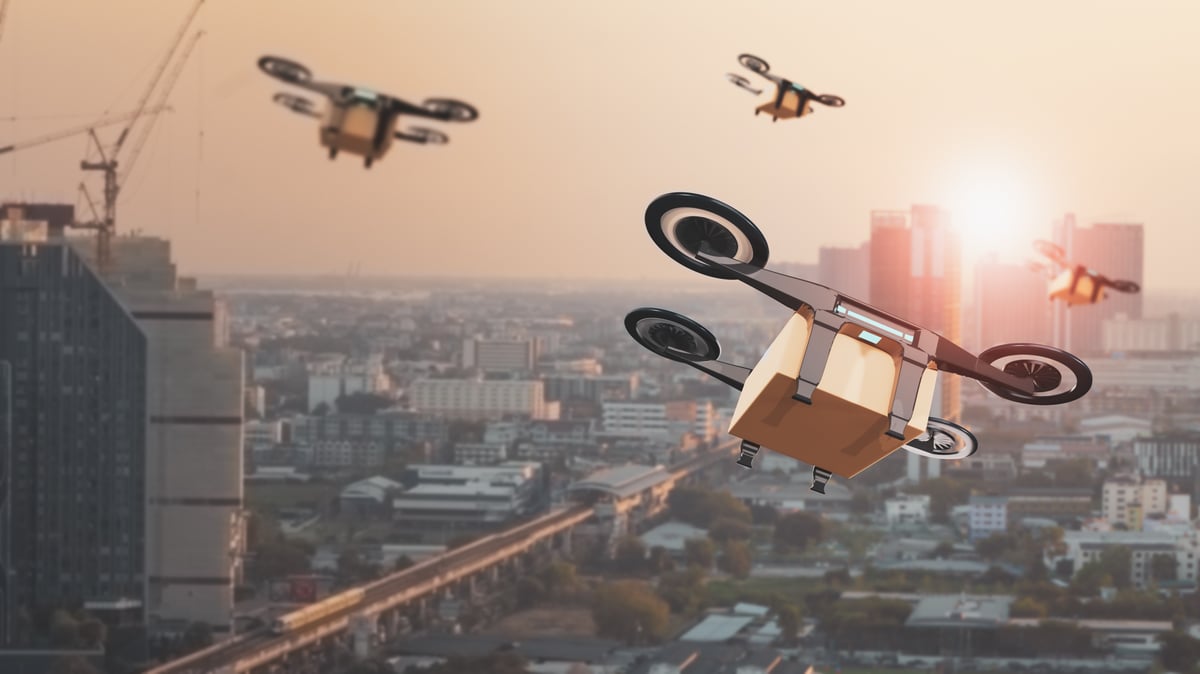As our societies grow increasing more conscious of the value of time, they demand more efficiency and speed in every service they utilize. The delivery logistics industry finds itself at the forefront of this climate of urgency, and as such is making great forays into the future by introducing advanced technologies such as drones to push their capabilities into this new frontier. Hussein Wehbe, a seasoned executive with more than 20 years of experience in the services and logistics industry, sheds light on the advent of drones and autonomous vehicles in this key sector.
Why do you consider delivery drones and autonomous delivery vehicles superior to the traditional man-and-van method?
The delivery industry is evolving rapidly and undergoing a major transformation in the GCC region following years of fierce competition between traditional players where the main battles centered around either services or prices.
However, the name of the game today is technology, which outperforms anything else when it comes to improving the customer experience across every facet of the delivery process.
Artificial intelligence, machine learning and predictive technologies are changing the way we schedule a delivery, anticipate a delay and exceed expectations. This will certainly have a positive impact on the logistics industry in region, and in particular greatly benefit the UAE economy.
How big a role does the logistics industry play in the UAE economy, and what are its capacities?
The logistics industry is a relatively a good contributor to the UAE’s GDP, and according to the Federal Competitiveness and Statistics Authority, the sector was expected to contribute 8% to the UAE economy during 2021, up from 5.4% previously according to the official UAE government portal.
Today, the UAE enjoys an excellent transportation infrastructure and is well positioned to attract more and more businesses to sell online and ride the booming wave of e-commerce, at a time when many free-zones are embracing the e-commerce wave by offering attractive licenses for players in the field, with 100% foreign ownership as the cherry on the top.
With all that being said, what’s next? When will we start seeing the next generation of delivery vehicles in full swing? How soon will we see a transition in the way parcels are delivered – whether across urban cityscapes or in remote areas – in advanced countries such as the UAE and the rest of the Gulf region?
This, of course, depends on governments’ future visions for the industry and their readiness to pilot and test those concepts from now. However, it will be a while until we see full implementation because regulations need to be established for all those new, innovative modes of transport and future delivery vehicles to ensure safety during their usage and a gradual shift from the pollutive modes of delivering packages that we employ today.
Delivery drones as well as autonomous delivery robots and vehicles are the hottest topics and the vanguard of the next generation of logistics that have begun to float to the surface through many POCs in the region. However, more time is needed before the traditional man-and-van delivery mechanism is replaced, and it will be interesting to witness the piloting of the next generation of transportation solutions that are being tested the UAE, a country that embraces the future with a clear vision.
In the coming years we expect to see more flexibility in how these new modes of transportation are regulated with new legislation and policies, which need to be drafted from scratch in order to govern the adoption of the 2.0 versions of these transportation fleets in the delivery industry.
We understand that the next generation will be serving greener cities and contributing to a major reduction in the carbon footprint. But just how many parcels can a drone deliver compared to a human service provider, and how efficient will those futuristic fleets be from an operational perspective?
Let’s be realistic; drones will never fully replace the ground delivery fleets, and this is due to delivery capacity limitations and also airspace safety challenges. A small-sized drone can carry one package at a time of up to 5 kgs, and you have bigger ones that may carry heavier weights but from an efficiency perspective it’s still not the best.
A drone can deliver faster, especially when you use it for remote areas and difficult-to-reach locations, and this is where drone deliveries will make a difference, but never from an operational delivery capacity point of view.
What about the man in the van? Are you not concerned that these technological advances will over time make their jobs redundant?
A man and a van are certainly heading toward a van without a man, and this is what autonomous vehicles and trucks are all about.
Technology will speed the deployment of autonomous delivery, but you will still need people to monitor those vehicles around the clock because anything can happen in tech-enabled machines. However, the number of people needed will certainly decrease.
What kind of catalyst is needed as a final push for the next generation of delivery vehicles to disrupt traditional approach?
Today, the first milestone in disrupting the traditional delivery process is the fierce competition on the fastest delivery time, and technically with the current infrastructure in the UAE, any delivery operator can arrange a quick delivery through traditional vehicles like a bike, a car or a van with a near-accurate estimated time of arrival from any origin to any destination across the UAE, irrespective of the high operational delivery cost for on-demand deliveries as speed is the name of the game.
Surprisingly, consumers don’t really care whether a parcel comes with a drone or a robot; all they need is a quick delivery as promised and a hassle-free experience without being disturbed. The mode of transportation tends to be more of a concern for the delivery companies from both an efficiency perspective as well as on remaining current with the latest trends that are shaping the transportation industry.
Quick commerce is already disrupting the next-day delivery service, which in the past was considered as a fast delivery time. However, with the lightning swiftness of food and grocery deliveries, the parcel industry is deemed as lagging and will need to catch up because consumers are benchmarking their expectations based on what they are getting from the grocery services today and leaning more toward a “I want it now” mindset for anything they order.
What kind of infrastructure does such a transition require? How broad does its scope need to be?
When we talk about preparing the infrastructure for the next generation of delivery services, we can’t ignore the importance of designing and constructing what we may call smart buildings and smart towers of the future, where IOT (Internet of Things) is a major component of every building material for any residential or commercial tower/facility/warehouse/building, in addition to drone landing stations and other high-tech amenities that can also be embedded in residential compounds.
Smart buildings are indeed the buildings of the future, which need to communicate with drones, autonomous delivery vehicles or any other advanced delivery vehicle in order to facilitate the process of receiving those hundreds of parcels each day, perhaps to central receiving bays on the roofs of those buildings or even in dedicated underground slots, with almost zero human involvement. This is where the Internet of Things comes into play, by connecting all the dots from the moment an order is placed until a delivery is completed in the smoothest way possible and with zero failures.
Requesting a delivery address may become a thing of the past, and perhaps parcels will never again lack a delivery address. Everything will be fully scheduled based on real-time data which, in a smart and connected city that enables accuracy in every service activity across every neighborhood, makes customer profiling super accurate with the click of button.
What about the costs involved in setting up such a logistics system? Won’t it be prohibitive?
With the rise of “quick commerce” and on-demand delivery within minutes, I don’t see a challenge at all in creating a nationwide crowdsourcing model as part of the creation of a sharing economy culture that allows anyone to delivery anything at any time, and based on very sophisticated algorithms and location spotting that ensure any delivery within the same city is completed within a few minutes.
The future of last mile logistics and transportation is very exciting, and we are lucky to be in a region that embraces the future while still living in the present.

Hussein is a seasoned executive with more than 20 years of experience in logistics industry in addition to government advisory. His prior experiences include his role as managing director for UPS in the Middle East. Before joining UPS, Wehbe served as a full-time adviser at the UAE’s Prime Minister’s Office after spending 17 years with logistics giant Aramex International, where he headed the company’s business in the Gulf region.








